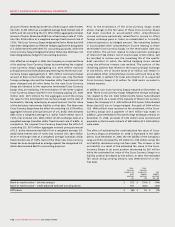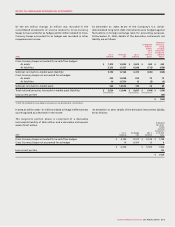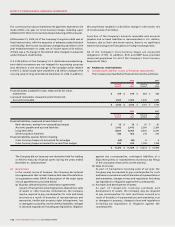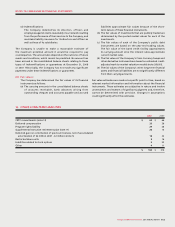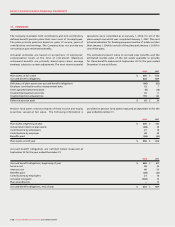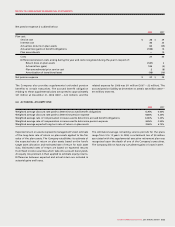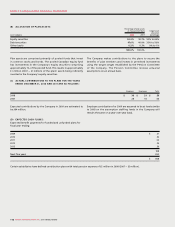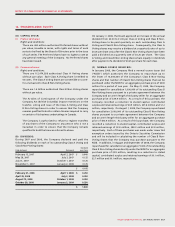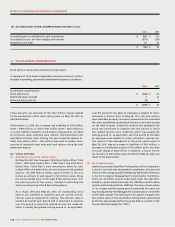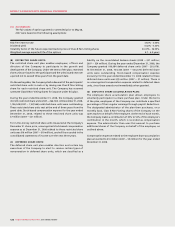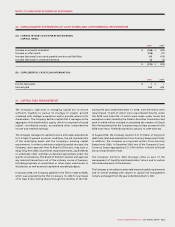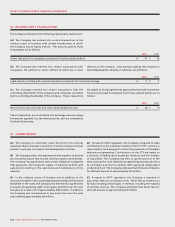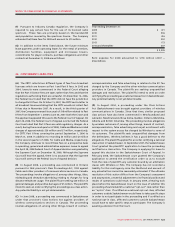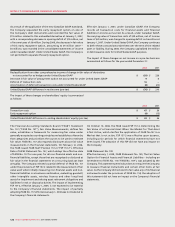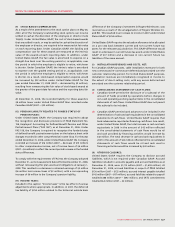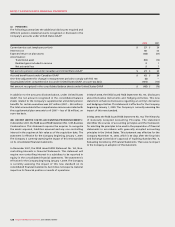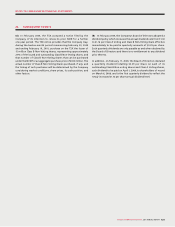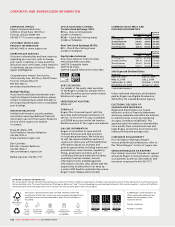Rogers 2008 Annual Report Download - page 124
Download and view the complete annual report
Please find page 124 of the 2008 Rogers annual report below. You can navigate through the pages in the report by either clicking on the pages listed below, or by using the keyword search tool below to find specific information within the annual report.
120 ROGERS COMMUNICATIONS INC. 2008 ANNUAL REPORT
NOTES TO CONSOLIDATED FINANCIAL STATEMENTS
(iv) Assumptions:
The fair values of options granted or amended prior to May 28,
2007 were based on the following assumptions:
Risk-free interest rate 3.92% - 4.00%
Dividend yield 0.42% - 0.43%
Volatility factor of the future expected market prices of Class B Non-Voting shares 34.47% - 36.55%
Weighted average expected life of the options 4.7 - 6.0 years
(B) RESTRICTED SHARE UNITS:
The restricted share unit plan enables employees, officers and
directors of the Company to participate in the growth and
development of the Company. Under the terms of the plan, restricted
share units are issued to the participant and the units issued vest over
a period not to exceed three years from the grant date.
On the vesting date, the Company shall redeem all of the participants’
restricted share units in cash or by issuing one Class B Non-Voting
share for each restricted share unit. The Company has reserved
4,000,000 Class B Non-Voting shares for issuance under this plan.
During the year ended December 31, 2008, the Company granted
451,535 restricted share units (2007 – 266,720). At December 31, 2008,
1,126,548 (2007 – 1,167,564) restricted share units were outstanding.
These restricted share units vest at the end of three years from the
grant date. Stock-based compensation expense for the year ended
December 31, 2008, related to these restricted share units was
$7 million (2007 – $21 million).
For in-the-money restricted share units measured at the Company’s
December 31 share price, unrecognized stock-based compensation
expense as at December 31, 2008 related to these restricted share
units was $16 million (2007 – $19 million), and will be recorded in the
consolidated statements of income over the next three years.
(C) DEFERRED SHARE UNITS:
The deferred share unit plan enables directors and certain key
executives of the Company to elect to receive certain types of
remuneration in deferred share units, which are classified as a
liability on the consolidated balance sheets (2008 – $27 million;
2007 – $24 million). During the year ended December 31, 2008, the
Company granted 186,084 deferred share units (2007 - 281,079).
At December 31, 2008, 730,454 (2007 – 544,370) deferred share
units were outstanding. Stock-based compensation expense
(recovery) for the year ended December 31, 2008 related to these
deferred share units was $(3) million (2007 – $7 million). There is
no unrecognized compensation expense related to deferred share
units, since these awards vest immediately when granted.
(D) EMPLOYEE SHARE ACCUMULATION PLAN:
The employee share accumulation plan allows employees to
voluntarily participate in a share purchase plan. Under the terms
of the plan, employees of the Company can contribute a specified
percentage of their regular earnings through payroll deductions.
The designated administrator of the plan then purchases, on a
monthly basis, Class B Non-Voting shares of the Company on the
open market on behalf of the employee. At the end of each month,
the Company makes a contribution of 25% to 50% of the employee’s
contribution in the month, which is recorded as compensation
expense. The administrator then uses this amount to purchase
additional shares of the Company on behalf of the employee, as
outlined above.
Compensation expense related to the employee share accumulation
plan amounted to $14 million (2007 – $9 million) for the year ended
December 31, 2008.


